Past and present artworks reflect traditional Chinese philosophy


The exhibition The Objects as Vessels of Wisdom showcases 29 pieces of Chinese Ming (1368-1644) and Qing (1644-1911) furniture collected by Prince Kung's Palace Museum and 28 contemporary ceramic artworks by 18 artists, which has attracted visitors since opening in late April.
Hosted by Prince Kung's Palace Museum, the exhibition explores the philosophical and aesthetic dialogue between classical Chinese craftsmanship and modern artistic expression.
The exhibition runs until July 6 and is divided into three sections.
The Simplicity as Splendor section features Ming Dynasty furniture, such as rosewood hat chairs that resemble the winged headwear worn by Ming and Qing officials, recessed-leg tables, and openwork cabinets. This section highlights the eras' restrained elegance. The classic pieces are arranged with contemporary ceramics, intending to create a "zero-distance" dialogue between two periods.

The From Ornate to Essential section presents opulent carvings and solemn hues of Qing Dynasty furniture which contrast with the vibrant blues of qinghua porcelain, the crimson of underglaze red wares, and the purity of dehua porcelain (Blanc de Chine) made in Fujian province.
The Dwelling in Nature section evokes the leisurely aesthetics of garden life, pairing low-back chairs and a scroll table with upturned ends with ceramic artworks depicting mountain ranges and porcelain-painted screens, echoing the poetic landscapes of the Prince Kung's Palace Museum's garden.
The exhibition was curated by the museum and Bai Ming, a professor at Tsinghua University's Academy of Arts and Design and director of the China Artists Association's ceramic art committee.
By juxtaposing historical and modern pieces, the exhibition reimagines cultural heritage and offers a montage of time and space to reflect traditional Chinese philosophies — harmony with nature, moral integrity, reverence for materials, and artistic ingenuity.





































